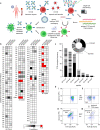Large libraries of single-chain trimer peptide-MHCs enable antigen-specific CD8+ T cell discovery and analysis
- PMID: 37193826
- PMCID: PMC10186326
- DOI: 10.1038/s42003-023-04899-8
Large libraries of single-chain trimer peptide-MHCs enable antigen-specific CD8+ T cell discovery and analysis
Abstract
The discovery and characterization of antigen-specific CD8+ T cell clonotypes typically involves the labor-intensive synthesis and construction of peptide-MHC tetramers. We adapt single-chain trimer (SCT) technologies into a high throughput platform for pMHC library generation, showing that hundreds can be rapidly prepared across multiple Class I HLA alleles. We use this platform to explore the impact of peptide and SCT template mutations on protein expression yield, thermal stability, and functionality. SCT libraries were an efficient tool for identifying T cells recognizing commonly reported viral epitopes. We then construct SCT libraries to capture SARS-CoV-2 specific CD8+ T cells from COVID-19 participants and healthy donors. The immunogenicity of these epitopes is validated by functional assays of T cells with cloned TCRs captured using SCT libraries. These technologies should enable the rapid analyses of peptide-based T cell responses across several contexts, including autoimmunity, cancer, or infectious disease.
© 2023. The Author(s).
Conflict of interest statement
J.R.H. is a founder and board member of Isoplexis and PACT Pharma. P.D.G. is on the scientific advisory board of Celsius, Earli, Elpiscience, Immunoscape, Rapt, Metagenomi, and Nextech, was a scientific founder of Juno Therapeutics, and receives research support from Lonza. J.D.G. declared contracted research with Gilead, Lilly, and Regeneron and served on an advisory board for Gilead. The remaining authors declare no competing interests.
Figures





Update of
-
Large libraries of single-chain trimer peptide-MHCs enable rapid antigen-specific CD8+ T cell discovery and analysis.Res Sq [Preprint]. 2022 Nov 18:rs.3.rs-1090664. doi: 10.21203/rs.3.rs-1090664/v1. Res Sq. 2022. Update in: Commun Biol. 2023 May 16;6(1):528. doi: 10.1038/s42003-023-04899-8. PMID: 36415462 Free PMC article. Updated. Preprint.
References
Publication types
MeSH terms
Substances
Grants and funding
LinkOut - more resources
Full Text Sources
Medical
Molecular Biology Databases
Research Materials
Miscellaneous

